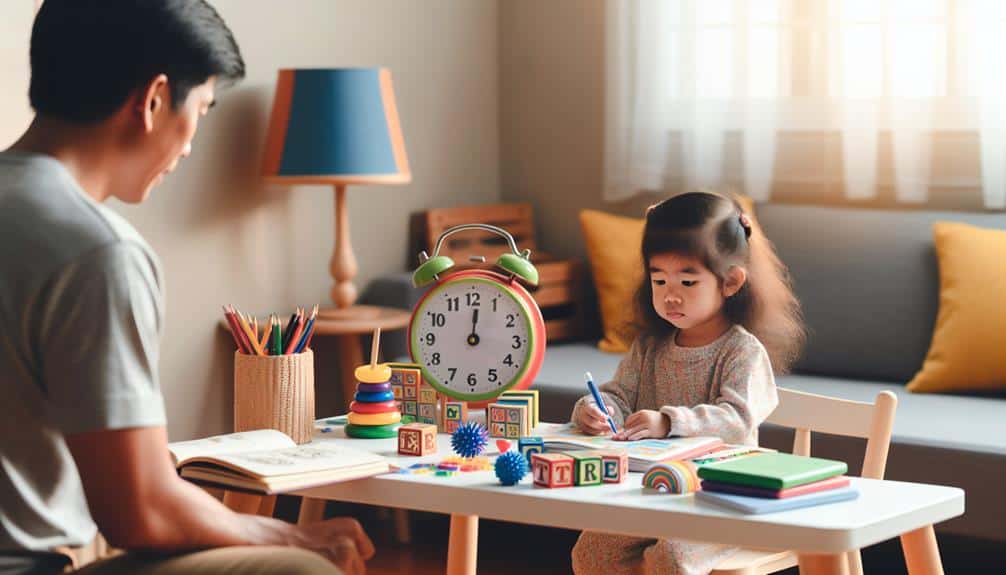Ready to transform your toddler's routine? Set a daily timetable for meals, naps, and play. Designate creative spaces for learning and fun. Schedule play breaks for outdoor activities and sensory play. Use visual schedules for organization and involve your child. Be open to adjustments based on interests and energy. Excited to make your homeschooling journey engaging and structured?
Key Points
- Set fixed times for meals, naps, and activities to create predictability and security.
- Designate specific learning spaces to enhance educational experiences and foster exploration.
- Include playtime breaks for outdoor exploration, sensory play, and creative arts.
- Use visual schedules to provide organization, involve the child, and encourage independence.
- Stay adaptable to evolving needs, switch activities, and remain flexible in homeschooling.
Setting Daily Timetable
Feeling overwhelmed with organizing your toddler's day? Let's simplify it by setting a structured daily timetable. Creating consistency is key to providing a sense of security for your little one. Start by establishing fixed times for meals, naps, and activities. This predictability helps toddlers feel secure and understand what comes next, fostering their independence.
Balancing structure is important, but remember to promote flexibility within your schedule. Allow room for spontaneous playtime and exploration. Flexibility encourages creativity and adaptability in your child, essential skills for their development. Consider incorporating breaks for free play, where your toddler can choose activities independently. This autonomy nurtures decision-making skills and boosts confidence.
Designating Learning Spaces
When organizing your toddler's day, consider creating designated learning spaces to enhance their educational experiences and foster a sense of curiosity and exploration. Designating specific areas for learning and play can help your little one associate different spaces with various activities, making the learning process more engaging and structured.
To organize learning spaces efficiently and creatively, start by identifying areas in your home where your toddler can focus without distractions. It could be a corner in the living room with a small table and chairs for reading time or a cozy rug for playtime activities. Personalizing these spaces with colorful posters, educational toys, and books can make them more inviting and exciting for your toddler.
Try to keep these areas organized and clutter-free to create a conducive environment for learning. Encourage your toddler to participate in tidying up after each session to instill a sense of responsibility and organization. By creating designated learning spaces, you aren't just organizing your home but also setting the stage for a fun and productive homeschool routine for your toddler.
Incorporating Playtime Breaks
To keep your toddler energized and engaged throughout the day, incorporating playtime breaks is essential for maintaining their focus and creativity. Outdoor exploration can be a fantastic way to break up the structured routine. Encourage your little one to discover nature's wonders, whether it's observing insects, feeling different textures, or simply enjoying the fresh air. Sensory play, like digging in a sandbox or splashing in water, stimulates their senses and provides a fun learning experience.
Incorporating creative arts into playtime breaks can awaken your toddler's imagination. Set up a mini art station with crayons, paper, and safe-to-use craft materials. Engage in imaginative play by pretending to be characters from their favorite story or letting them create their own fantastical world. These activities not only entertain but also nurture their cognitive and emotional development.
Utilizing Visual Schedules
Maximize your toddler's potential by incorporating visual schedules into their structured homeschool routine. Visual prompts can provide the organization and predictability that toddlers thrive on. By creating a visual schedule together, you aren't only setting clear expectations but also fostering interactive engagement.
Start by involving your child in the process of making the schedule. Use colorful pictures or drawings to represent different activities throughout the day, such as reading time, snack breaks, or playtime. This interactive approach helps them understand the flow of the day and gives them a sense of control and independence.
Place the visual schedule in a central location where your toddler can easily see and refer to it. Encourage them to check the schedule independently and guide them through each activity. As they become familiar with the routine, you may notice a smoother handover between tasks and a greater sense of accomplishment in your little one.
Adapting as Needed
For flexibility and seamless changes in your toddler's homeschool routine, be open to adapting as needed to cater to their evolving needs and interests. Flexibility is key when it comes to homeschooling toddlers. Your little one's interests and energy levels can vary from day to day, so it's important to remain adaptable.
Important is vital, but so is the ability to pivot when necessary. If you notice that a certain activity isn't engaging your child or if they seem restless, don't be afraid to switch things up. Maybe a hands-on project would be more exciting than a worksheet, or perhaps outdoor time is needed to burn off some energy.




